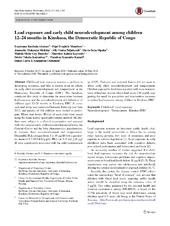| dc.contributor.author | Kashala Abotnes, Esperance | en_US |
| dc.contributor.author | Mumbere, Pépé Penghele | en_US |
| dc.contributor.author | Mishika, Jeannette Mukanya | en_US |
| dc.contributor.author | Ndjukendi, Ally Omba | en_US |
| dc.contributor.author | Mpaka, Davin Beya | en_US |
| dc.contributor.author | Bumoko, Makila-Mabe Guy | en_US |
| dc.contributor.author | Kayembe, Tharcisse Kalula | en_US |
| dc.contributor.author | Tshala-Katumbay, Désiré | en_US |
| dc.contributor.author | Kazadi, Theodore Kayembe | en_US |
| dc.contributor.author | Okitundu, Daniel Luwa E-Andjafono | en_US |
| dc.date.accessioned | 2017-01-04T14:53:01Z | |
| dc.date.available | 2017-01-04T14:53:01Z | |
| dc.date.issued | 2016-12 | |
| dc.Published | European Child and Adolescent Psychiatry 2016, 25:1361-1367 | eng |
| dc.identifier.issn | 1435-165X | |
| dc.identifier.uri | https://hdl.handle.net/1956/15342 | |
| dc.description.abstract | Childhood lead exposure remains a problem in developing countries, and little is known about its effects on early child neurodevelopment and temperament in the Democratic Republic of Congo (DRC). We, therefore, conducted this study to determine the association between lead exposure and the neurodevelopment and behaviour of children aged 12–24 months in Kinshasa, DRC. A cross-sectional study was conducted between February and June 2012, and parents of 104 children were invited to participate. Blood lead levels (BLLs) of each child were tested using the flame atomic spectrophotometry method. All children were subject to a clinical examination and assessed with two selected early child neurodevelopmental tools, the Gensini–Gavito and the baby characteristics questionnaire, to measure their neurodevelopment and temperament. Detectable BLLs ranged from 1 to 30 μg/dl with a geometric mean of 6.9 (SD 4.8) μg/dl. BLLs at 5–9 and ≥10 μg/dl were significantly associated with the child temperament (p <0.05). Perinatal and maternal factors did not seem to affect early child neurodevelopment and temperament. Children exposed to lead were reported with more temperament difficulties at even blood lead levels <10 μg/dl, suggesting the need for preventive and intervention measures to reduce lead exposure among children in Kinshasa, DRC. | en_US |
| dc.language.iso | eng | eng |
| dc.publisher | Springer | eng |
| dc.rights | Attribution CC BY | eng |
| dc.rights.uri | http://creativecommons.org/licenses/by/4.0 | eng |
| dc.subject | Childhood | eng |
| dc.subject | Lead exposure | eng |
| dc.subject | Neurodevelopment | eng |
| dc.subject | Temperament | eng |
| dc.subject | Kinshasa/DRC | eng |
| dc.title | Lead exposure and early child neurodevelopment among children 12–24 months in Kinshasa, the Democratic Republic of Congo | en_US |
| dc.type | Peer reviewed | |
| dc.type | Journal article | |
| dc.date.updated | 2016-12-15T10:15:46Z | |
| dc.description.version | publishedVersion | en_US |
| dc.rights.holder | Copyright 2016 The Author(s) | |
| dc.identifier.doi | https://doi.org/10.1007/s00787-016-0860-3 | |
| dc.identifier.cristin | 1357012 | |

